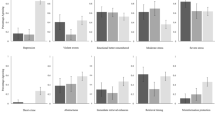Abstract
Many people who report paranormal sightings (e.g., Bigfoot and UFO aliens) are apparently sincere. This places many such sightings in the category of eyewitness errors, rather than of deliberate deception. Recent research has supported this idea; in an earlier paper, we demonstrated that paranormal beliefs are facilitated by tendencies toward attention deficit hyperactive disorder, dissociation, and depression. These characteristics predicted specific patterns of beliefs in several paranormal phenomena. The present research addressed the question of whether such psychological tendencies would tend to create bias in perception and interpretation as well as in belief- in whether a person’s identification of a given stimulus as paranormal in nature would be influenced by the same factors previously demonstrated to influence paranormal beliefs. This hypothesis was supported. Specifically, those with dissociative tendencies were significantly more likely to identify given stimulus items as paranormal in nature than were those with lower dissociation scores. Dissociation was further shown to be related to paranormal beliefs, consistent with earlier findings. Results are discussed in terms of the reconfigurative dynamics known to operate in areas of human cognition such as eyewitness identification, and in terms of the generality of those effects to the realm of paranormal sightings.
Similar content being viewed by others
References
Ahlberg, S. W., & Sharps, M. J. (2002). Bartlett revisited: reconfiguration of long-term memory in young and older adults. The Journal of Genetic Psychology, 163, 211–218.
Bartlett, F. C. (1932). Remembering: A study in experimental and social psychology. Cambridge: Cambridge University Press.
Beck, A. T. (1996). Beck depression inventory- II. San Antonio: Psychological Corporation.
Bergman, E. T., & Roediger, H. L. (1999). Can Bartlett’s repeated reproduction experiments be replicated? Memory & Cognition, 27, 937–947.
Blades, H. B. (2005). The Washington, D.C., sniper case: a case study in how eyewitness identification of vehicles can go wrong. Forensic Examiner, 14, 26.
Burke, A., Heuer, F., & Reisberg, D. (1992). Remembering emotional events. Memory & Cognition, 20, 277–290.
Carlson, E. B., & Putnam, F. W. (1986). Development, reliability, and validity of a dissociation scale. Journal of Nervous and Mental Disorders, 174, 727–735.
Coleman, L., & Clark, J. (1999). Cryptozoology A to Z. New York: Simon & Schuster.
Conners, C. K., Erhardt, D., & Sparrow, E. (1999). Conners’ CAARS adult ADHD rating scales. New York: Multi-Health Systems.
DePrince, A. P., & Freyd, J. F. (1999). Dissociative tendencies, attention, and memory. Psychological Science, 10, 449–452.
Hartmann, T. (1997). Attention deficit disorder. Grass Valley: Underwood.
Horwitz, S., & Ruane, M. E. (2003). Sniper. New York: Ballantine.
James, P., & Thorpe, N. (1999). Ancient mysteries. New York: Ballantine.
Mackal, R. P. (1976). The monsters of Loch Ness. Chicago: Swallow.
Narby, D. J., Cutler, B. L., & Penrod, S. D. (1996). The effects of witness, target, and situational factors in eyewitness identifications. In S. L. Sporer, R. S. Malpass, & G. Koehnken (Eds.), Psychological issues in eyewitness identification (pp. 23–52). Mahwah: Erlbaum.
Sharps, M. J. (2003). Aging, representation, and thought: Gestalt and feature-intensive processing. Piscataway: Transaction.
Sharps, M. J. (2010). Processing under pressure: Stress, memory, and decision-making in law enforcement. Flushing: Looseleaf Law.
Sharps, M. J., Matthews, J., & Asten, J. (2006). Cognition, affect, and beliefs in paranormal phenomena: Gestalt/feature intensive processing theory and tendencies toward ADHD, depression, and dissociation. The Journal of Psychology, 140, 579–590.
Sharps, M. J., Janigian, J., Hess, A. B., & Hayward, B. (2009). Eyewitness memory in context: toward a taxonomy of eyewitness error. Journal of Police and Criminal Psychology, 24, 36–44.
Shepherd, J. W., & Ellis, H. D. (1996). Face recall- methods and problems. In S. L. Sporer, R. S. Malpass, & G. Koehnken (Eds.), Psychological issues in eyewitness identification (pp. 87–116). Mahwah: Erlbaum.
Sporer, S. L., Malpass, R. S., & Koehnken, G. (1996). Psychological issues in eyewitness identification. Mahwah: Erlbaum.
Steiger, B. (1978). Project blue book. New York: Sphere.
Tobacyk, J. (2004). A revised paranormal belief scale. International Journal of Transpersonal Studies, 23, 94–98.
U.S. Department of Justice. (1999). Eyewitness evidence: A guide for law enforcement. Washington: National Institute of Justice.
Wheeler, M. A., & Roediger, H. L. (1992). Disparate results of repeated testing: reconciling Ballard’s (1913) and Bartlett’s (1932) results. Psychological Science, 3, 240–245.
Wylie, K. (1980). Bigfoot. New York: Viking.
Author information
Authors and Affiliations
Corresponding author
Rights and permissions
About this article
Cite this article
Sharps, M.J., Newborg, E., Van Arsdall, S. et al. Paranormal Encounters as Eyewitness Phenomena: Psychological Determinants of Atypical Perceptual Interpretations. Curr Psychol 29, 320–327 (2010). https://doi.org/10.1007/s12144-010-9091-9
Published:
Issue Date:
DOI: https://doi.org/10.1007/s12144-010-9091-9




